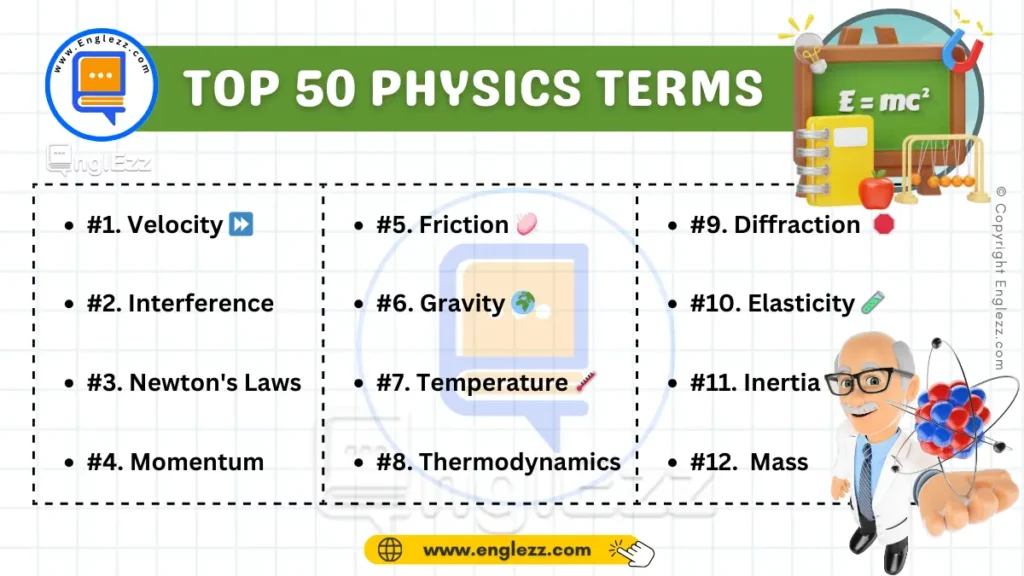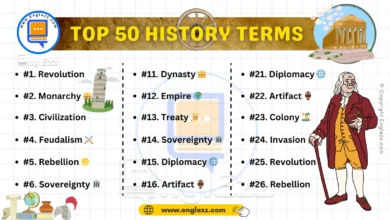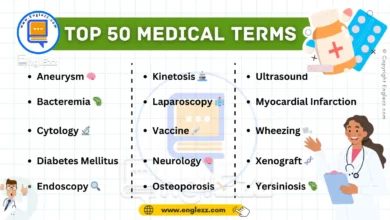Understanding key physics terms is crucial for mastering the subject. Whether you’re a high school student preparing for exams or a college student tackling advanced topics, a solid grasp of these terms can significantly enhance your comprehension and problem-solving skills. This blog post presents 50 essential physics English terms that every student should know.
Table of Contents
- 50 Physics English Terms Every Student Must Know
- #1. Acceleration 🚀
- #2. Force 💪
- #3. Energy ⚡
- #4. Velocity 🌪️
- #5. Momentum ⚙️
- #6. Newton’s Laws 📜
- #7. Gravity 🌍
- #8. Work 💼
- #9. Power ⚙️
- #10. Friction 🔥
- #11. Kinetic Energy 🌠
- #12. Potential Energy 🌌
- #13. Conservation of Energy 🔄
- #14. Wave 🌊
- #15. Frequency 🔁
- #16. Amplitude 📏
- #17. Photon 🌟
- #18. Quantum 🔬
- #19. Relativity 🌌
- #20. Thermodynamics 🔥
- #21. Electromagnetism ⚡
- #22. Optics 👓
- #23. Nuclear Physics ☢️
- #24. Magnetism 🧲
- #25. Gravitational Field 🌌
- #26. Centripetal Force 🌀
- #27. Inertia 🛑
- #28. Elasticity 🧪
- #29. Diffraction 🌈
- #30. Interference 🎨
- #31. Quantum Mechanics 🔬
- #32. Relativistic Mass 🏋️
- #33. Electric Field ⚡
- #34. Magnetic Field 🧲
- #35. Capacitance ⚙️
- #36. Inductance 🔋
- #37. Photoelectric Effect 💡
- #38. Brownian Motion 🔍
- #39. Law of Conservation of Momentum 📚
- #40. Superposition Principle 🧩
- #41. Periodic Motion 🔄
- #42. Heat Transfer 🌡️
- #43. Specific Heat Capacity 🧪
- #44. Bernoulli’s Principle 🌪️
- #45. Einstein’s Theory of Relativity 🧠
- #46. Lorentz Force 🧲
- #47. Tension 🪢
- #48. Hertz 📏
- #49. Scalar Quantity 📐
- #50. Vector Quantity ➡️
- Physics English Terms Table
- Conclusion
50 Physics English Terms Every Student Must Know
From basic concepts to more advanced terminology, we’ve included detailed definitions, phonetic transcriptions, and practical examples for each term. Our aim is to provide a valuable resource that will aid your studies and help you excel in your physics coursework.
By familiarizing yourself with these terms, you’ll not only improve your academic performance but also build a strong foundation for future learning. Dive into our guide and start mastering these crucial physics concepts today!
Discover the top 50 physics English terms every student must know. This comprehensive guide provides definitions, phonetic transcriptions, and examples for each term to help you master physics concepts. Perfect for students and educators alike!
#1. Acceleration 🚀
- Definition: The rate at which an object’s velocity changes over time.
- Phonetic Transcription: /ˌæk.səˈleɪ.ʃən/
- Examples:
- An airplane’s acceleration during takeoff.
- A car accelerating from 0 to 60 mph in 6 seconds.
#2. Force 💪
- Definition: An interaction that causes an object to change its motion or shape.
- Phonetic Transcription: /fɔːrs/
- Examples:
- The force you apply to push a door open.
- The gravitational force that keeps us grounded on Earth.
#3. Energy ⚡
- Definition: The capacity to do work or produce change.
- Phonetic Transcription: /ˈen.ər.dʒi/
- Examples:
- The kinetic energy of a moving car.
- The potential energy stored in a compressed spring.

#4. Velocity 🌪️
- Definition: The speed of an object in a given direction.
- Phonetic Transcription: /vəˈlɒs.ɪ.ti/
- Examples:
- A runner’s velocity during a sprint.
- The velocity of a spacecraft orbiting Earth.
#5. Momentum ⚙️
- Definition: The quantity of motion an object has, determined by its mass and velocity.
- Phonetic Transcription: /məˈmen.təm/
- Examples:
- A moving train has high momentum due to its mass and velocity.
- A baseball hit by a bat gains momentum in the direction it is struck.
#6. Newton’s Laws 📜
- Definition: Three fundamental laws describing the relationship between a body and the forces acting upon it.
- Phonetic Transcription: /ˈnjuː.tənz lɔːz/
- Examples:
- Newton’s first law explains why a car continues to move forward until a force acts on it.
- Newton’s second law is applied in calculating the acceleration of a falling object.
#7. Gravity 🌍
- Definition: The force that attracts two bodies toward each other.
- Phonetic Transcription: /ˈɡræv.ɪ.ti/
- Examples:
- The Earth’s gravity keeps the Moon in orbit.
- Objects fall to the ground because of gravity.
#8. Work 💼
- Definition: The transfer of energy that occurs when a force is applied over a distance.
- Phonetic Transcription: /wɜːrk/
- Examples:
- Lifting a box up involves doing work against gravity.
- Pushing a cart across a store involves work done by the applied force.
#9. Power ⚙️
- Definition: The rate at which work is done or energy is transferred.
- Phonetic Transcription: /ˈpaʊ.ər/
- Examples:
- The power output of an engine determines how fast a car can go.
- A light bulb’s power rating indicates how much energy it uses.
#10. Friction 🔥
- Definition: The resistance that one surface or object encounters when moving over another.
- Phonetic Transcription: /ˈfrɪk.ʃən/
- Examples:
- Friction between the tires and the road surface helps a car to stop.
- Friction between a pencil and paper produces graphite marks.
#11. Kinetic Energy 🌠
- Definition: The energy possessed by an object due to its motion.
- Phonetic Transcription: /kɪˈnɛt.ɪk ˈen.ər.dʒi/
- Examples:
- A rolling ball has kinetic energy due to its motion.
- A speeding bullet has high kinetic energy.
#12. Potential Energy 🌌
- Definition: The stored energy of an object due to its position or configuration.
- Phonetic Transcription: /pəˈten.ʃəl ˈen.ər.dʒi/
- Examples:
- A stretched spring has potential energy.
- Water stored at a height in a reservoir has potential energy.
#13. Conservation of Energy 🔄
- Definition: A principle stating that energy cannot be created or destroyed, only transformed.
- Phonetic Transcription: /ˌkɒn.səˈveɪ.ʃən əv ˈen.ər.dʒi/
- Examples:
- In a roller coaster, potential energy converts to kinetic energy as it descends.
- A bouncing ball’s energy transforms between kinetic and potential forms.
#14. Wave 🌊
- Definition: A disturbance that travels through space and matter, transferring energy.
- Phonetic Transcription: /weɪv/
- Examples:
- Sound waves travel through air to reach your ears.
- Water waves carry energy across the surface of the ocean.
#15. Frequency 🔁
- Definition: The number of occurrences of a repeating event per unit of time.
- Phonetic Transcription: /ˈfriː.kwən.si/
- Examples:
- The frequency of a radio station determines the broadcasted signal.
- The frequency of a vibrating string determines the pitch of the sound.
#16. Amplitude 📏
- Definition: The maximum extent of a vibration or oscillation, measured from the position of equilibrium.
- Phonetic Transcription: /ˈæmp.lɪ.tjuːd/
- Examples:
- The amplitude of a sound wave affects its volume.
- The amplitude of ocean waves affects their height.
#17. Photon 🌟
- Definition: A particle representing a quantum of light or other electromagnetic radiation.
- Phonetic Transcription: /ˈfoʊ.tɒn/
- Examples:
- Photons are emitted when an electron moves to a lower energy level.
- Sunlight consists of photons that travel to Earth.
#18. Quantum 🔬
- Definition: The smallest amount of a physical quantity that can exist independently.
- Phonetic Transcription: /ˈkwɒn.təm/
- Examples:
- The concept of quantum states explains electron configurations in atoms.
- Quantum leaps describe sudden transitions between energy levels.
#19. Relativity 🌌
- Definition: The theory formulated by Einstein that describes the relationship between space and time.
- Phonetic Transcription: /ˌrɛl.əˈtɪv.ɪ.ti/
- Examples:
- Time dilation explains why astronauts age slower than people on Earth.
- Relativity helps us understand the behavior of objects moving close to the speed of light.
#20. Thermodynamics 🔥
- Definition: The branch of physics concerned with the relationships between heat and other forms of energy.
- Phonetic Transcription: /ˌθɜːr.moʊ.daɪˈnæm.ɪks/
- Examples:
- Thermodynamics principles explain how refrigerators work.
- Engines convert chemical energy into mechanical energy through thermodynamic processes.
#21. Electromagnetism ⚡
- Definition: The branch of physics involving the study of electric and magnetic fields and their interactions.
- Phonetic Transcription: /ɪˌlɛk.trəʊˌmæg.nəˈtɪz.əm/
- Examples:
- Electromagnetic waves include radio waves and light.
- Electric currents generate magnetic fields in motors.
#22. Optics 👓
- Definition: The study of light and its interactions with matter.
- Phonetic Transcription: /ˈɒp.tɪks/
- Examples:
- Lenses in glasses use optics to correct vision.
- Optics principles are applied in microscopes and telescopes.
#23. Nuclear Physics ☢️
- Definition: The study of atomic nuclei and their interactions.
- Phonetic Transcription: /ˈnjuː.klɪər ˈfɪz.ɪks/
- Examples:
- Nuclear reactions power nuclear reactors and atomic bombs.
- Understanding nuclear fusion is key to developing energy sources like the sun.
#24. Magnetism 🧲
- Definition: The physical phenomenon produced by the motion of electric charge, resulting in attractive and repulsive forces between objects.
- Phonetic Transcription: /ˈmæɡ.nə.tɪ.zəm/
- Examples:
- Earth’s magnetic field helps compass needles point north.
- Magnets are used in various devices, such as MRI machines.
#25. Gravitational Field 🌌
- Definition: The region of space surrounding a massive body where its gravitational influence can be felt.
- Phonetic Transcription: /ˌɡræv.ɪˈteɪ.ʃən.əl fiːld/
- Examples:
- The gravitational field of Earth keeps satellites in orbit.
- Objects fall toward Earth due to its gravitational field.
#26. Centripetal Force 🌀
- Definition: The force that acts on an object moving in a circular path, directed towards the center of the circle.
- Phonetic Transcription: /sɛnˈtrɪp.ɪ.təl fɔːrs/
- Examples:
- A car moving around a curve experiences centripetal force.
- Planets orbit the sun due to centripetal force from gravitational attraction.
#27. Inertia 🛑
- Definition: The resistance of any physical object to a change in its state of motion.
- Phonetic Transcription: /ɪˈnɜːr.ʃə/
- Examples:
- A passenger lurches forward in a car when it suddenly stops due to inertia.
- A stationary object remains at rest until acted upon by a force.
#28. Elasticity 🧪
- Definition: The ability of a material to return to its original shape after deformation.
- Phonetic Transcription: /ɪˌlæstɪˈsɪti/
- Examples:
- A rubber band stretches and returns to its original shape.
- Elasticity in metals allows them to bend and return to their shape.
#29. Diffraction 🌈
- Definition: The bending of light around obstacles and the spreading of light waves when they pass through small openings.
- Phonetic Transcription: /dɪˈfræk.ʃən/
- Examples:
- Diffraction causes the spreading of light when passing through a narrow slit.
- CD surfaces diffract light to produce a spectrum of colors.
#30. Interference 🎨
- Definition: The interaction of waves that results in a new wave pattern.
- Phonetic Transcription: /ˌɪn.təˈfɪə.rəns/
- Examples:
- Light interference creates colorful patterns in soap bubbles.
- Sound waves can cancel each other out in noise-canceling headphones.
#31. Quantum Mechanics 🔬
- Definition: The branch of physics that deals with the behavior of particles at the atomic and subatomic levels.
- Phonetic Transcription: /ˈkwɒn.təm mɪˈkæn.ɪks/
- Examples:
- Quantum mechanics explains the behavior of electrons in atoms.
- It describes phenomena like particle-wave duality.
#32. Relativistic Mass 🏋️
- Definition: The mass of an object as it approaches the speed of light, which increases due to relativistic effects.
- Phonetic Transcription: /ˌrɛl.əˈtɪv.ɪs.tɪk mæs/
- Examples:
- A particle accelerator increases the relativistic mass of particles.
- High-speed particles exhibit increased mass according to relativity.
#33. Electric Field ⚡
- Definition: A field around charged particles that exerts a force on other charged particles.
- Phonetic Transcription: /ɪˈlɛk.trɪk fiːld/
- Examples:
- Electric fields are responsible for the force between charged objects.
- The field around a charged balloon attracts small bits of paper.
#34. Magnetic Field 🧲
- Definition: A field around a magnet or current-carrying conductor where magnetic forces are observable.
- Phonetic Transcription: /mægˈnɛt.ɪk fiːld/
- Examples:
- A magnetic field can be visualized using iron filings around a magnet.
- Earth’s magnetic field protects us from solar radiation.
#35. Capacitance ⚙️
- Definition: The ability of a system to store an electric charge.
- Phonetic Transcription: /kəˈpæs.ɪ.təns/
- Examples:
- Capacitors in electronic circuits store and release electrical energy.
- Capacitance is measured in farads.
#36. Inductance 🔋
- Definition: The property of a conductor by which a change in current induces an electromotive force (EMF) in itself or nearby circuits.
- Phonetic Transcription: /ɪnˈdʌk.təns/
- Examples:
- Inductors in electronic devices use inductance to filter signals.
- Inductance plays a role in transformers and coils.
#37. Photoelectric Effect 💡
- Definition: The emission of electrons from a material when it is exposed to light.
- Phonetic Transcription: /ˌfoʊ.toʊ.ɪˈlek.trɪk ɪˈfɛkt/
- Examples:
- Solar panels use the photoelectric effect to generate electricity.
- The effect is used in photoelectric sensors for detecting light.
#38. Brownian Motion 🔍
- Definition: The random movement of particles suspended in a fluid, resulting from their collision with fast atoms or molecules.
- Phonetic Transcription: /ˈbraʊ.ni.ən ˈmoʊ.ʃən/
- Examples:
- Brownian motion is observed in dust particles floating in the air.
- It can be seen under a microscope with pollen grains in water.
#39. Law of Conservation of Momentum 📚
- Definition: The total momentum of a closed system remains constant if no external forces act on it.
- Phonetic Transcription: /lɔː ɒv ˌkɒn.səˈveɪ.ʃən ɒv mɒˈmen.təm/
- Examples:
- Momentum conservation explains why rockets can propel themselves in space.
- Collisions in billiards illustrate momentum conservation.
#40. Superposition Principle 🧩
- Definition: The principle stating that when two or more waves overlap, the resulting wave is the sum of the individual waves.
- Phonetic Transcription: /ˌsuː.pə.pəˈzɪʃ.ən ˈprɪn.sɪ.pəl/
- Examples:
- Superposition principle is used in analyzing wave interference patterns.
- It helps explain how multiple sound waves combine in acoustics.
#41. Periodic Motion 🔄
- Definition: Motion that repeats itself at regular intervals.
- Phonetic Transcription: /ˌpɪə.riˈɒd.ɪk ˈmoʊ.ʃən/
- Examples:
- A swinging pendulum exhibits periodic motion.
- The motion of a vibrating guitar string is periodic.
#42. Heat Transfer 🌡️
- Definition: The movement of thermal energy from a hotter object to a cooler one.
- Phonetic Transcription: /hiːt ˈtræn.sfɜːr/
- Examples:
- Heat transfer occurs when you touch a hot stove.
- Thermal insulation reduces heat transfer in buildings.
#43. Specific Heat Capacity 🧪
- Definition: The amount of heat required to raise the temperature of one kilogram of a substance by one degree Celsius.
- Phonetic Transcription: /spɪˈsɪf.ɪk hiːt kəˈpæs.ɪ.ti/
- Examples:
- Water has a high specific heat capacity, which helps regulate body temperature.
- Metals generally have lower specific heat capacities compared to water.
#44. Bernoulli’s Principle 🌪️
- Definition: A principle stating that an increase in the speed of a fluid occurs simultaneously with a decrease in pressure.
- Phonetic Transcription: /bɜːrˈnuː.li z ˈprɪn.sɪ.pəl/
- Examples:
- Bernoulli’s principle explains how airplanes generate lift.
- It is used in the design of carburetors for internal combustion engines.
#45. Einstein’s Theory of Relativity 🧠
- Definition: A theory that describes how space and time are linked for objects moving at a constant speed in a straight line.
- Phonetic Transcription: /ˈaɪnˌstaɪnz ˈθɪəri ɒv ˌrɛl.əˈtɪv.ɪ.ti/
- Examples:
- Time dilation near massive objects is predicted by Einstein’s theory.
- The theory explains gravitational bending of light.
#46. Lorentz Force 🧲
- Definition: The force experienced by a charged particle moving through an electromagnetic field.
- Phonetic Transcription: /lɒˈrɛnts fɔːrs/
- Examples:
- Lorentz force affects the motion of electrons in a magnetic field.
- It plays a key role in the operation of electric motors.
#47. Tension 🪢
- Definition: The force exerted along a stretched rope, string, or wire.
- Phonetic Transcription: /ˈten.ʃən/
- Examples:
- Tension in a climbing rope supports the weight of the climber.
- The tension in a suspension bridge cable helps support the bridge’s load.
#48. Hertz 📏
- Definition: The unit of frequency, equal to one cycle per second.
- Phonetic Transcription: /hɜːrts/
- Examples:
- Radio stations are broadcasted at various frequencies measured in Hertz.
- The frequency of sound waves is measured in Hertz.
#49. Scalar Quantity 📐
- Definition: A physical quantity that has magnitude but no direction.
- Phonetic Transcription: /ˈskeɪ.lər ˈkwɒn.tɪ.ti/
- Examples:
- Temperature is a scalar quantity because it only has magnitude.
- Mass is a scalar quantity representing the amount of matter in an object.
#50. Vector Quantity ➡️
- Definition: A physical quantity that has both magnitude and direction.
- Phonetic Transcription: /ˈvɛk.tər ˈkwɒn.tɪ.ti/
- Examples:
- Velocity is a vector quantity because it includes both speed and direction.
- Force is a vector quantity as it has both magnitude and direction.
Physics English Terms Table
| #1. Acceleration 🚀 | #11. Optics 🔭 | #21. Nuclear Physics ☢️ |
| #2. Force 💪 | #12. Momentum 🚀 | #22. Magnetism 🧲 |
| #3. Energy ⚡ | #13. Kinematics 🎥 | #23. Gravitational Field 🌌 |
| #4. Work 🛠️ | #14. Power ⚡ | #24. Centripetal Force 🌀 |
| #5. Velocity ⏩ | #15. Friction 🧼 | #25. Inertia 🛑 |
| #6. Mass ⚖️ | #16. Acceleration Due to Gravity 🌍 | #26. Elasticity 🧪 |
| #7. Newton’s Laws 📜 | #17. Temperature 🌡️ | #27. Diffraction 🌈 |
| #8. Momentum Conservation 📚 | #18. Thermodynamics 🔥 | #28. Interference 🎨 |
| #9. Wave 🌊 | #19. Quantum Mechanics 🔬 | #29. Relativistic Mass 🏋️ |
| #10. Frequency 🎵 | #20. Electromagnetic Spectrum 📡 | #30. Electric Field ⚡ |
Conclusion
A solid understanding of physics terms is essential for success in studying the subject. The 50 terms outlined in this post are fundamental concepts that will enhance your comprehension and ability to apply physics principles effectively.
Each term, accompanied by its definition, phonetic transcription, and practical examples, provides a well-rounded overview of the crucial vocabulary needed for mastering physics. By familiarizing yourself with these terms, you’ll be better equipped to tackle complex problems and engage more deeply with the material.
Whether you’re preparing for exams or just looking to strengthen your grasp of physics, this guide serves as an invaluable resource. Continue to review and apply these terms to build a robust foundation in physics that will support your academic and professional endeavors. Happy studying!









🔬Unlock the secrets of physics with our comprehensive guide to the 50 essential English terms every student must know!🌟 Dive into the key concepts with clear definitions and practical examples that will enhance your understanding and boost your academic performance.
🚀 For more insights, follow and like @EnglEzz! Explore our post here:
https://www.englezz.com/50-essential-physics-english-terms/
.
#EnglEzz #Vocabulary #Linguistics #PhysicsTerms #StudyGuide #Education #StudentSuccess #ScienceEducation #AcademicGrowth